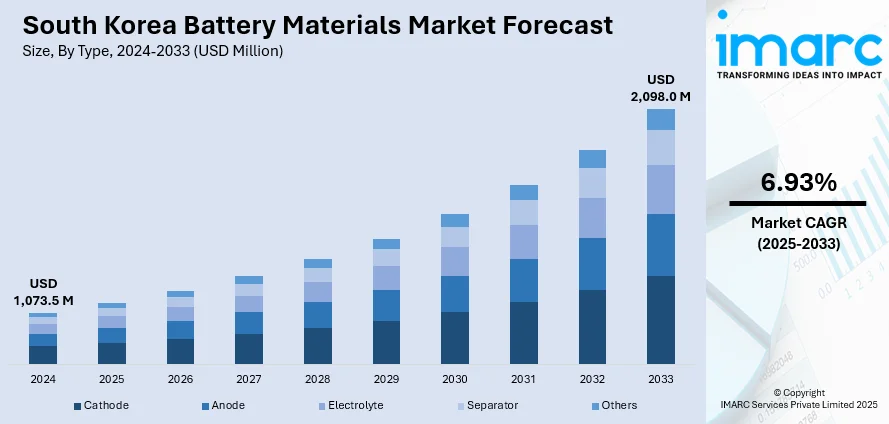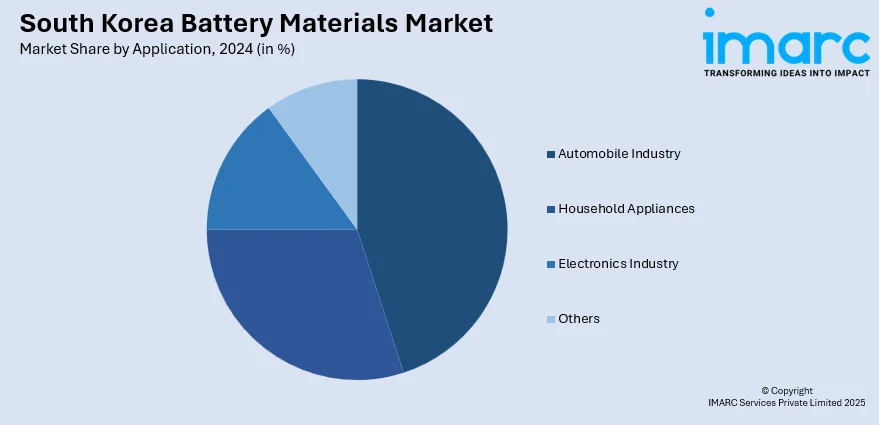
South Korea Battery Materials Market Size, Share, Trends and Forecast by Type, Battery Type, Application, and Region, 2025-2033
South Korea Battery Materials Market Overview:
The South Korea battery materials market size reached USD 1,073.5 Million in 2024. The market is projected to reach USD 2,098.0 Million by 2033, exhibiting a growth rate (CAGR) of 6.93% during 2025-2033. The market is driven by strong government support through policies that foster research and development (R&D), local manufacturing, and international supply chain partnerships. Rising global demand for electric vehicles and energy storage systems fuels growth, as manufacturers expand to meet clean energy goals. Additionally, South Korean firms are integrating vertically securing raw materials and advancing battery technologies to ensure supply stability and innovation leadership. This combined focus on policy, demand, and technological strength South Korea battery materials market share.
|
Report Attribute
|
Key Statistics
|
|---|---|
|
Base Year
|
2024
|
|
Forecast Years
|
2025-2033
|
|
Historical Years
|
2019-2024
|
| Market Size in 2024 | USD 1,073.5 Million |
| Market Forecast in 2033 | USD 2,098.0 Million |
| Market Growth Rate 2025-2033 | 6.93% |
South Korea Battery Materials Market Trends:
Government Policy & Strategic Investment
South Korea views the battery business as one of its main pillars for a future economy and is developing it through in-depth, long-term plans. The government is backing the industry with financial incentives, regulatory renewal, and robust public–private partnership. These are designed to promote indigenous manufacture of battery materials, reduce dependence on imports, and create a more secure and stable supply chain. South Korea also fosters international partnerships to secure key minerals and invites investment in next-generation battery technology. By harmonizing its regulation with global standards of the environment and trade, the nation keeps its companies competitive globally. Embedding the innovation of batteries in industrial policy, South Korea is developing a strong ecosystem that underpins technological progress, economic development, and dominance in energy storage and electric mobility solutions.

To get more information on this market, Request Sample
Rising Demand for Electric Vehicles & Energy Storage
The growing shift toward cleaner energy and sustainable transport is a powerful force behind South Korea’s battery materials market growth. Domestic and global demand for electric vehicles continues to rise, prompting automakers and battery producers to expand production capacity. At the same time, the integration of renewable energy into power grids calls for efficient energy storage solutions. These parallel trends—electrified mobility and smart energy management—are driving the need for high-performance battery materials. South Korea’s strong manufacturing base, combined with its innovation-driven approach, makes it a key player in supplying materials for these technologies. The demand extends beyond cars, reaching sectors like residential energy storage, smart homes, and industrial backup systems. This ecosystem of growing applications ensures continuous expansion and development in the battery materials industry.
Supply Chain Integration & Technological Leadership
South Korea’s battery materials market benefits from the Region’s drive to control every stage of the value chain from sourcing raw materials to producing finished components is a significant South Korea battery materials market trend. Companies are investing in global partnerships, overseas mining operations, and local refining to build a resilient supply network. At the same time, there's a focus on advanced technologies that enhance battery performance, safety, and affordability. This includes next-generation battery chemistries and eco-friendly production methods. By combining supply chain depth with strong R&D, South Korean firms are positioning themselves as leaders in the global battery race. These integrated strategies reduce exposure to market volatility and geopolitical risks while encouraging innovation. The Region’s holistic approach ensures its long-term competitiveness in the fast-evolving landscape of battery materials and clean energy technologies.
South Korea Battery Materials Market Segmentation:
IMARC Group provides an analysis of the key trends in each segment of the market, along with forecasts at the Region and regional levels for 2025-2033. Our report has categorized the market based on type, battery type, and application.
Type Insights:
- Cathode
- Anode
- Electrolyte
- Separator
- Others
The report has provided a detailed breakup and analysis of the market based on the type. This includes cathode, anode, electrolyte, separator, and others.
Battery Type Insights:
- Lithium Ion
- Lead Acid
- Others
A detailed breakup and analysis of the market based on the battery type have also been provided in the report. This includes lithium ion, lead acid, and others.
Application Insights:

- Automobile Industry
- Household Appliances
- Electronics Industry
- Others
A detailed breakup and analysis of the market based on the application have also been provided in the report. This includes automobile industry, household appliances, electronics industry, and others.
Region Insights:
- Seoul Capital Area
- Yeongnam (Southeastern Region)
- Honam (Southwestern Region)
- Hoseo (Central Region)
- Others
The report has also provided a comprehensive analysis of all the major regional markets, which include Seoul Capital Area, Yeongnam (Southeastern Region), Honam (Southwestern Region), Hoseo (Central Region), and Others.
Competitive Landscape:
The market research report has also provided a comprehensive analysis of the competitive landscape. Competitive analysis such as market structure, key player positioning, top winning strategies, competitive dashboard, and company evaluation quadrant has been covered in the report. Also, detailed profiles of all major companies have been provided.
South Korea Battery Materials Market News:
- In June 2025, POSCO Future M completed a precursor plant in Gwangyang, South Korea, establishing a China-free cathode material supply chain. The facility will produce high-nickel precursors for export to Ultium Cells, a GM–LG Energy joint venture. This move reduces reliance on Chinese imports, strengthens global competitiveness, and aligns with U.S. IRA regulations. The plant marks a major step in POSCO Future M's strategy to secure independent, high-quality battery material production.
- In May 2025, Amprius Technologies formed a strategic manufacturing partnership with a leading South Korean battery maker to expand its global production of SiCore® silicon anode cells. The collaboration boosts supply chain resilience and supports high-performance battery delivery for aerospace, defense, and electric mobility sectors. This capital-light approach enables Amprius to scale efficiently, streamline logistics, and meet rising global demand while accelerating commercialization of its next-generation, high-energy battery technologies.
- In April 2025, South Korea inaugurated its largest rechargeable battery research center, the Battery Solution Testbed Zone (BST Zone), in Cheongju, North Chungcheong Province. Announced by the Ministry of Trade, Industry and Energy on April 22, 2025, the center will advance research across the entire battery production process—including materials, components, cells, and modules. It will also support the development of next-generation technologies such as solid-state batteries.
South Korea Battery Materials Market Report Coverage:
| Report Features | Details |
|---|---|
| Base Year of the Analysis | 2024 |
| Historical Period | 2019-2024 |
| Forecast Period | 2025-2033 |
| Units | Million USD |
| Scope of the Report |
Exploration of Historical Trends and Market Outlook, Industry Catalysts and Challenges, Segment-Wise Historical and Future Market Assessment:
|
| Types Covered | Cathode, Anode, Electrolyte, Separator, Others |
| Battery Types Covered | Lithium Ion, Lead Acid, Others |
| Applications Covered | Automobile Industry, Household Appliances, Electronics Industry, Others |
| Regions Covered | Seoul Capital Area, Yeongnam (Southeastern Region), Honam (Southwestern Region), Hoseo (Central Region), Others |
| Customization Scope | 10% Free Customization |
| Post-Sale Analyst Support | 10-12 Weeks |
| Delivery Format | PDF and Excel through Email (We can also provide the editable version of the report in PPT/Word format on special request) |
Key Questions Answered in This Report:
- How has the South Korea battery materials market performed so far and how will it perform in the coming years?
- What is the breakup of the South Korea battery materials market on the basis of type?
- What is the breakup of the South Korea battery materials market on the basis of battery type?
- What is the breakup of the South Korea battery materials market on the basis of application?
- What is the breakup of the South Korea battery materials market on the basis of region?
- What are the various stages in the value chain of the South Korea battery materials market?
- What are the key driving factors and challenges in the South Korea battery materials market?
- What is the structure of the South Korea battery materials market and who are the key players?
- What is the degree of competition in the South Korea battery materials market?
Key Benefits for Stakeholders:
- IMARC’s industry report offers a comprehensive quantitative analysis of various market segments, historical and current market trends, market forecasts, and dynamics of the South Korea battery materials market from 2019-2033.
- The research report provides the latest information on the market drivers, challenges, and opportunities in the South Korea battery materials market.
- Porter's five forces analysis assist stakeholders in assessing the impact of new entrants, competitive rivalry, supplier power, buyer power, and the threat of substitution. It helps stakeholders to analyze the level of competition within the South Korea battery materials industry and its attractiveness.
- Competitive landscape allows stakeholders to understand their competitive environment and provides an insight into the current positions of key players in the market.
Need more help?
- Speak to our experienced analysts for insights on the current market scenarios.
- Include additional segments and countries to customize the report as per your requirement.
- Gain an unparalleled competitive advantage in your domain by understanding how to utilize the report and positively impacting your operations and revenue.
- For further assistance, please connect with our analysts.
 Request Customization
Request Customization
 Speak to an Analyst
Speak to an Analyst
 Request Brochure
Request Brochure
 Inquire Before Buying
Inquire Before Buying




.webp)




.webp)












